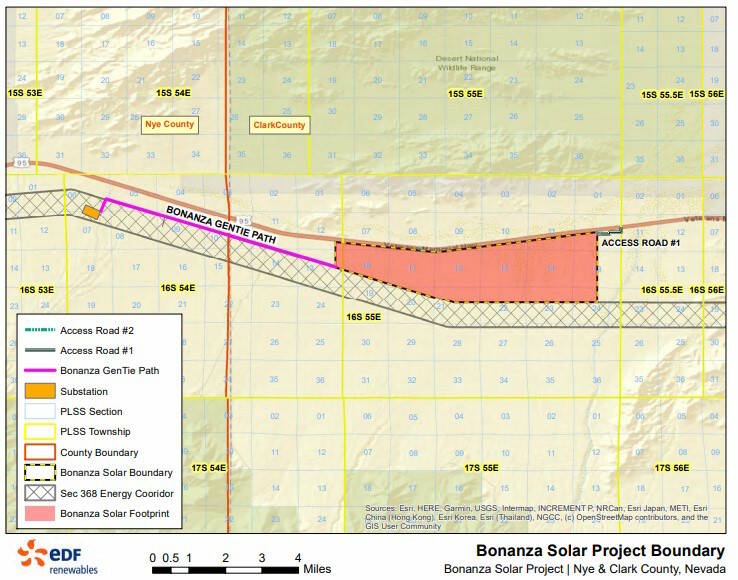How you can sound off on the Bonanza Solar project near the Nye-Clark line
The Bureau of Land Management is seeking public comments on the Bonanza Solar Project, in Clark and Nye counties.
If approved as proposed, this project would generate up to 300 megawatts of solar energy and would include 300 megawatts of battery storage for communities in southwestern Nevada.
The proposal, which includes the construction, operation and eventual decommissioning of solar panels, battery energy storage, and associated infrastructure, would occupy approximately half of the 5,133-acre application area on public lands west of Indian Springs, approximately 30 miles northwest of Las Vegas.
Project construction is anticipated to take 12 months.
Potential threats to desert species
Representatives with Basin & Range Watch, a conservation group that monitors solar development in the area, say they located several Mojave desert tortoises on the site just north of Cactus Springs in April. The species would be threatened by development there, they say.
“These tortoise would have to be dug out of their burrows and translocated, resulting in a certain percentage of mortality,” they say. “We find this unacceptable when solar panels can go on disturbed lands, on rooftops and over parking lots.”
A notice of intent to amend the Las Vegas Resource Management Plan and prepare an Environmental Impact Statement for the proposed Bonanza Solar Project in Clark and Nye counties published in the Federal Register June 5, opening a 45-day public comment period that closes July 20.
Comments the BLM received during the solar variance process for the project, which was completed in April, will also be considered for development of the Environmental Impact Statement.
More information, including information on how to provide comment, is available on the project ePlanning website.
The BLM manages vast stretches of public lands that have the potential to make significant contributions to the nation’s renewable energy portfolio.
To promote the development of these energy sources, the BLM provides sites for environmentally sound development of renewable energy on public lands.
The efficient deployment of renewable energy from our nation’s public lands is crucial in achieving the Biden-Harris administration’s goal of a carbon pollution-free power sector by 2035, as well as Congress’ direction in the Energy Act of 2020 to permit 25 gigawatts of solar, wind, and geothermal production on public lands no later than 2025.
For more information, contact Brian Buttazoni, planning & environmental specialist at 775-861-6491 or email at Bonanzasolar@blm.gov.


















